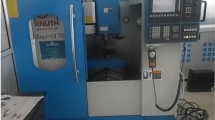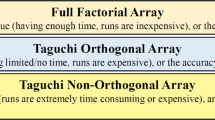Abstract
In the last few years, there is a demand for developing new technologies in order to increase scrap reuse potential and CO2 emission savings. In this paper, aluminum was recycled from chips obtained by machining without any remelting in order to reduce environmental pollution and to increase material yield during the process. This process is called solid-state recycling (SSR) or direct recycling. SSR process consists of chips cleaning, cold pre-compaction, and hot direct extrusion followed by equal channel angular pressing (ECAP) at different temperatures. Influence of direct extrusion temperature, ECAP temperature, and number of ECAP passes on electrical conductivity and microhardness of the recycled EN AW 6082 aluminum chips was investigated. Microhardness and electrical conductivity of the recycled samples were comparable with commercially produced EN AW 6082. Experiments were planned utilizing design of experiments approach. Both adaptive neuro-fuzzy interference system (ANFIS) and regression models were developed and compared to describe the influence of input SSR process parameters on electrical conductivity and microhardness. Density and metallographic analysis of the recycled samples were also performed.
Similar content being viewed by others
References
Allwood JM, Cullen JM, Carruth MA (2012) Sustainable materials with both eyes open. UIT Cambridge ISBN 190686005X, 9781906860059
International Aluminium Institute (2009) Global aluminium recycling: a cornerstone of sustainable development. Online: http://www.world-aluminium.org/publications/. Accessed 23 August 2017
Duflou JR, Tekkaya AE, Haase M, Welo T, Vameemsel K, Kellens K, Dewulf W, Paraskevas D (2015) Environmental assessment of solid state recycling routes for aluminium alloys: can solid state processes significantly reduce the environmental impact of aluminium recycling? CIRP Ann Manuf Technol 64:37–40
Gronostajski J, Marciniak H, Matuszak A (2000) New methods of aluminium and aluminium-alloy chips recycling. J Mater Process Technol 106:34–39
Paraskevas D et al (2016) 4.10 resource efficiency in manufacturing: identifying low impact paths. The 10th global conference on sustainable manufacturing, pp 271-276
Gronostajski J, Matuszak A (1999) The recycling of metals by plastic deformation: an example of recycling of aluminum and its alloy chips. J Mater Process Technol 92:35–41
Chiba R, Nakamura T, Kuroda M (2011) Solid-state recycling of aluminum alloy swarf through cold profile extrusion and cold rolling. J Mater Process Technol 211:1878–1887
Haase M, Ben Khalifa N, Tekkaya AE, Misiolek WZ (2012) Improving mechanical properties of chip-based aluminum extrudates by integrated extrusion and equal channel angular pressing (iECAP). Mater Sci Eng A 539:194–204
Mohamed Ibrahim AEA, Eun Yoo Y, Hyoung SK (2013) Recycling of AlSi8Cu3 alloy chips via high pressure torsion. Mater Sci Eng A 560:121–128
Tang W, Reynolds AP (2010) Production of wire via friction extrusion of aluminum alloy machining chips. J Mater Process Technol 210:2231–2237
Tekkaya AE, Schikorra M, Becker D, Biermann D, Hammer N, Pantke K (2009) Hot profile extrusion of AA-6060 aluminum chips. J Mater Process Technol 209:3343–3350
Cooper DR, Allwood JM (2014) The influence of deformation conditions in solid-state aluminium welding processes on the resulting weld strength. J Mater Process Technol 214:2576–2592
Shamsudin S, Lajis MA, Zhong ZW (2016) Solid-state recycling of light metals: a review. Adv Mech Eng 8:1–23
Ab Rahim SN, Lajis MA, Ariffin S (2015) A review on recycling aluminum chips by hot extrusion process. 12th Global Conference on Sustainable Manufacturing 2015. Procedia CIRP 26:761–766
Behrens BA, Frischkorn C, Bonhage M (2014) Reprocessing of AW2007, AW6082 and AW7075 aluminium chips by using sintering and forging operations. Prod Eng Res Dev 8:443–451
Sherafat Z, Paydar MH, Ebrahimi R (2010) Mechanical properties and deformation behavior of Al/Al7075, two-phase material. J Alloys Compd 502:123–126
Southwire Company (2012) Direct solid-state conversion of recyclable metals and alloys, in Final Technical Report; Oak Ridge, TN Industry Technologies Program, Southwire Company and Oak Ridge National Laboratory. The Welding Institute-England. Online: https://www.osti.gov/scitech/servlets/purl/1039705 , Accessed 29 Jan 2018
Valiev RZ, Murashkin YM, Sabirov I (2014) A nanostructural design to produce high-strength Al alloys with enhanced electrical conductivity. Scr Mater 76:13–16
Lipińska M, Bazarnik P, Lewandowska M (2016) The influence of severe plastic deformation processes on electrical conductivity of commercially pure aluminium and 5483 aluminium alloy. Arch Civil Mech Eng 16:717–723
Murashkin M, Medvedev A, Kazykhanov V, Krokhin A, Raab G, Enikeev N, Valiev RZ (2015) Enhanced mechanical properties and electrical conductivity in ultrafine-grained Al 6101 alloy processed via ECAP-conform. Metals 5:2148–2164
Murashkin MY, Sabirov I, Kazykhanov VU, Bobruk EV, Dubravina AA, Valiev RZ (2013) Enhanced mechanical properties and electrical conductivity in ultrafine-grained Al alloy processed via ECAP-PC. J Mater Sci 48:4501–4509
Sauvage X, Bobruk EV, Murashkin MY, Nasedkina Y, Enikeev NA, Valiev RZ (2015) Optimization of electrical conductivity and strength combination by structure design at the nanoscale in Al–mg–Si alloys. Acta Mater 98:355–366
Lela B, Krolo J, Jozić S (2016) Mathematical modeling of solid-state recycling of aluminum chips. Int J Adv Manuf Technol 87:1125–1136
Mohammad AA et al (2015) Optimization of friction stir extrusion (FSE) parameters through Taguchi technique. Transaction of the indian institute of metals
Khamis SS, Lajis MA, Albert RAO (2015) A sustainable direct recycling of aluminum chip (AA6061) in hot press forging employing response surface methodology. 12th Global Conference on Sustainable Manufacturing. Procedia CIRP 26:477–481
Reddy BS, Kumar JS, Kumar KV (2009) Prediction of surface roughness in turning using adaptive neuro-fuzzy inference system. Jordan J Mech Ind Eng 3:252–259
Jang JSR (1993) Adaptive-network-based fuzzy inference system (ANFIS). IEEE Int Conf Syst Man Cybern 23:665–685
Veić M, Jozić S, Bajić D (2017) Development and optimization of surface roughness predictive models in turning super duplex stainless steel by using artificial intelligence methods. 7th International Conference, Mechanical Technology and Structural Materials. Proceeding in Mechanical technologies and structural materials, pp 149-158
Denai MA, Palis F, Zeghbib A (2004) ANFIS based modelling and control of non-linear systems. IEEE Int Conf Syst Man Cybern 4:3433–3438
Mohd Faridh AZ, Donghyun K, Sehun R (2017) An ANFIS based approach for predicting the weld strength of resistance spot welding in artificial intelligence development. J Mech Sci Technol 31:5467–5476
Jang J-S R (1991) Fuzzy modeling using generalized neural networks and Kalman filter algorithm. The Ninth National Conference on Artificial Intelligence 2:762–767
Rodger JA (2017) Forecasting of radio frequency identification entropy viscosity parking and forwarding algorithm flow risks and costs: integrated supply chain health manufacturing system (ISCHMS) approach. EEE Journal of Radio Frequency Identification 1:267–278. https://doi.org/10.1109/JRFID.2018.2795801
Mao-liang HU, Zesheng J, Chen X, Zhang Z (2008) Effect of chip size on mechanical property and microstructure of AZ91D magnesium alloy prepared by solid state recycling. Mater Charact 385-389
Cui J, Kvithyld A, Roven H (2010) Degreasing of aluminum turning and implications for solid-state recycling. Minerals, Metals and Materials Society, AIME, Warrendale
Cui J et al (2011) Recycling of aluminum scrap by severe plastic deformation. Mater Sci Forum Trans Tech Publ 667-669:1177–1182
Iwahashi Y, Wang J, Horita Z, Nemoto M, Langdon TG (1996) Principle of equal-channel angular pressing for the processing of ultra-fine grained materials. Scr Mater 35:143–146
Greger M, Madaj M, Žaček D (2014) Structural and mechanical properties of EN aw 6082 aluminum alloy produced by equal-channel angular pressing. Mater Technol 48:953–958
Paraskevas D, Vanmeensel K, Vleugels J, Dewulf W, Deng Y, Duflou JR (2014) Spark plasma sintering as a solid-state recycling technique: the case of aluminum alloy scrap consolidation. Mater Sci Eng 7:5664–5687
Shamsudin S, Zhong ZW, Ab Rahim SN, Lajis MA (2017) The influence of temperature and preheating time in extrudate quality of solid-state recycled aluminum. Int J Adv Manuf Technol 90:2631–2643
Fujda M, Kvačkaj T (2007) Microstructure and mechanical properties of EN AW 6082 aluminium alloy prepared by equal-channel angular pressing. J Metals Mater Miner 17:23–27
Güley V, Khalifa N B, Tekkaya A E (2011) The effect of extrusion ratio and material flow on the mechanical properties of aluminum profiles solid state recycled from 6060 aluminum alloy chips. The 14th International ESAFORM Conference on Material Forming 1:1609–1614
Author information
Authors and Affiliations
Corresponding author
Ethics declarations
Conflict of interest
None.
Rights and permissions
About this article
Cite this article
Krolo, J., Lela, B., Švagelj, Z. et al. Adaptive neuro-fuzzy and regression models for predicting microhardness and electrical conductivity of solid-state recycled EN AW 6082. Int J Adv Manuf Technol 100, 2981–2993 (2019). https://doi.org/10.1007/s00170-018-2893-x
Received:
Accepted:
Published:
Issue Date:
DOI: https://doi.org/10.1007/s00170-018-2893-x




